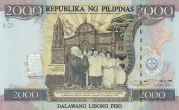Exchange your Philippine Peso
Do you have leftover Philippine Pesos? We offer a fast and easy way to exchange both current and withdrawn Philippine Peso banknotes and coins. Convert them into your local currency today with our quick and hassle-free exchange service.
₱ - PHP
The Philippine Peso has been in use since the Spanish colonial period and continues to support the Philippines’ economy, particularly in trade and remittances.
Philippine Peso Information
The Philippine Peso (PHP) is the official currency of the Philippines, a Southeast Asian nation with a rich cultural history. The Peso has been in use since the Spanish colonial period and has undergone several changes in design and structure over the years.
The name “peso” is derived from the Spanish word for “weight,” reflecting the currency’s origins during the period of Spanish rule in the Philippines.
The Philippine Peso is subdivided into 100 centavos, and the currency is issued in both coins and banknotes. Coins are available in denominations ranging from 1 centavo to 10 pesos, while banknotes are issued in denominations of 20, 50, 100, 200, 500, and 1,000 pesos. The designs on Philippine Peso banknotes feature prominent national figures,
cultural landmarks, and historical symbols, including images of revolutionary leaders such as José Rizal and depictions of the country’s natural wonders like the Tubbataha Reefs.
The Philippine economy is diverse, with key sectors including agriculture, manufacturing, services, and remittances from overseas Filipino workers. The stability of the Philippine Peso plays a crucial role in supporting the country’s economic growth, particularly in its trade relationships with other Asian nations, the United States, and Europe. The Peso is essential for facilitating transactions in goods such as electronics, textiles, and agricultural products, which are among the country’s main exports.
The Bangko Sentral ng Pilipinas (Central Bank of the Philippines) is responsible for issuing the Philippine Peso and managing the country’s monetary policy. The central bank’s main objectives are to maintain price stability, control inflation, and promote economic growth. The Peso has faced challenges related to inflation and global market fluctuations, but the central bank has implemented measures to stabilise the currency and support the nation’s financial stability.
One of the unique aspects of the Philippine Peso is its role in supporting the livelihoods of millions of overseas Filipino workers, whose remittances are a key component of the country’s economy. The value of the Peso is influenced by factors such as global commodity prices, economic developments in the Philippines’ trading partners, and domestic policies.
In conclusion, the Philippine Peso has been the official currency of the Philippines for centuries and plays a central role in supporting the country’s economic growth and trade.
It remains a symbol of the nation’s rich history and its efforts to maintain financial stability in a globalised world.















